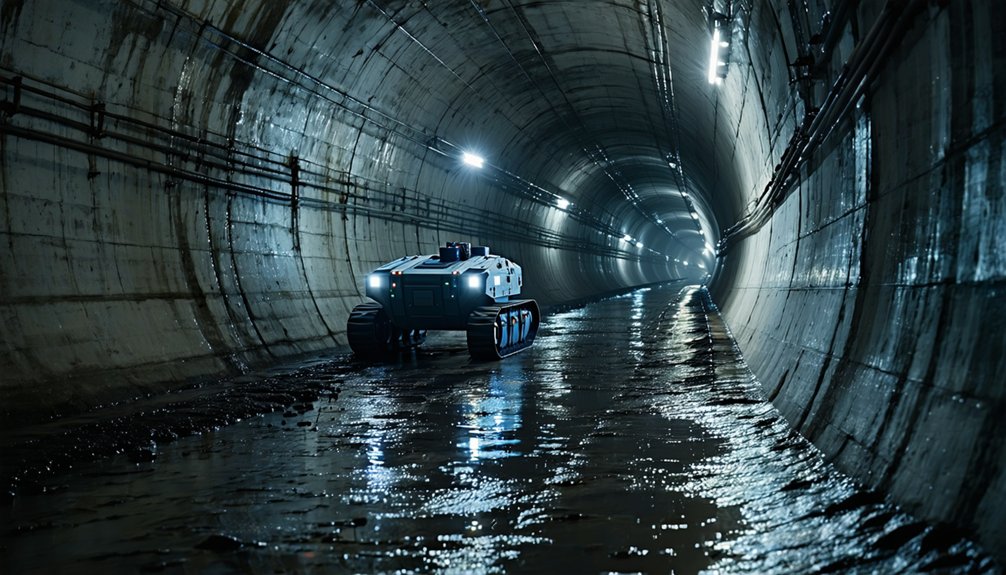Advanced techniques for sewer inspections enhance efficiency and accuracy while reducing costs and maintenance disruptions. Utilizing technologies such as robotic cameras and sonar, these methods provide high-resolution images and detailed 3D models, allowing for precise identification of blockages and leaks. They support compliance with environmental regulations and contribute to public health by preventing contamination. By adopting these modern approaches, organizations can optimize sewer management and extend the lifespan of systems. Further exploration reveals additional benefits and technologies.
Benefits of Advanced Sewer Inspection Techniques
Although traditional sewer inspection methods have served their purpose, the adoption of advanced techniques offers distinct advantages that greatly enhance inspection outcomes. Advanced technology, such as robotic inspection cameras and sonar tools, improves accuracy by delivering high-resolution images and detailed 3D models, enabling precise identification of blockages and structural issues within plumbing systems. These non-invasive methods minimize the need for costly excavations, thereby preserving surrounding infrastructure and landscapes while conserving time and resources.
Regular sewer inspections utilizing these advanced techniques facilitate early detection of potential issues, greatly preventing costly repairs and guaranteeing effective preventative maintenance. Furthermore, the integration of advanced inspection software provides real-time footage and thorough documentation, enhancing communication and strategic planning for maintenance. Ultimately, employing such advanced methods not only extends the lifespan of sewer systems but also guarantees compliance with environmental regulations, safeguarding public health and preventing contamination.
Comparison of Traditional vs. Modern Inspection Methods
As sewer inspection methods have evolved, a clear distinction emerges between traditional and modern approaches. Traditional methods often relied on labor-intensive techniques, which were not only time-consuming but also prone to human error. In contrast, modern inspection techniques employ advanced technology, such as robotic camera inspections and sonar, to provide:
- High-Definition Imaging: Captures detailed information with extensive views of sewer interiors.
- Enhanced Accuracy: Effectively identifies issues like small cracks and leaks that traditional methods often miss.
- Efficiency in Time and Cost: Reduces inspection duration, facilitating quicker maintenance planning and problem resolution.
The integration of software with modern tools further enhances data analysis, offering actionable insights that traditional methods cannot support. Ultimately, the shift to modern inspection techniques represents a significant improvement in sewer inspection, optimizing both effectiveness and resource allocation.
Key Technologies Revolutionizing Sewer Inspections
Innovative technologies are fundamentally transforming sewer inspections, enhancing both the efficiency and effectiveness of the process. Advanced techniques, such as sewer inspection cameras and robotic camera inspections, utilize remote-controlled high-definition visuals to accurately identify problems like blockages and leaks. Additionally, sonar technology employs sound waves to create detailed 3D models of sewer interiors, aiding in precise repair planning by mapping changes in pipe size and direction.
The integration of Closed-Circuit Television (CCTV) inspections enables high-resolution video assessments without invasive digging, minimizing disruption and associated costs. This combination of CCTV and sonar technology fosters a proactive approach, improving maintenance strategies by detecting potential issues preemptively, thereby averting costly repairs. Furthermore, maintenance software integrated with inspection technology organizes asset condition data, facilitating informed decision-making and optimizing overall sewer system management. These advancements are pivotal for the plumbing industry, driving efficiency and cost-effectiveness in sewer inspections.
Frequently Asked Questions
What Are the Benefits of a Sewer Scope Inspection?
A sewer scope inspection offers numerous benefits, emphasizing sewer maintenance importance through regular inspection frequency recommendations. It effectively identifies common sewer issues such as root intrusions, which can adversely affect plumbing system longevity and property value. The advancements in detection technology enhance diagnostic accuracy, while professional inspections provide insights that DIY methods may overlook. Additionally, early detection contributes to environmental benefits by minimizing waste and costly repairs, ensuring the integrity of the sewer infrastructure.
What Are the Methods of Sewer System Inspection?
Sewer inspection methods encompass a range of techniques designed to assess system integrity. Visual inspection techniques examine surface indicators, while CCTV technology usage provides detailed pipe interior views. Sonar sewer scanning detects underwater anomalies, and acoustic pipe testing identifies leaks. Smoke testing methods reveal infiltration issues, and dye testing procedures track wastewater flow. Robotic inspection systems enhance data collection, while vacuum excavation benefits facilitate access. Trenchless technology applications minimize disruption during assessments.
What Are the Technologies Used in Inspecting and Clearing Choke in Sewer?
Sewer inspection technologies have evolved to include advanced imaging techniques that enhance pipe condition assessments. Robotic crawlers equipped with CCTV cameras provide real-time visuals of sewer interiors, while sonar technology offers digital mapping of obstructions. Hydro jetting and sewer snake tools are employed for clearing blockages efficiently. Additionally, thermal imaging can identify temperature variations within pipes, assisting in diagnosing issues. Together, these technologies optimize inspection processes and guarantee effective clearing of sewer chokes.
What Is the Average Cost to Camera a Sewer in MD?
What factors truly determine the average sewer costs in Maryland? The average camera inspection pricing typically ranges from $150 to $500, influenced by regional pricing variations, plumbing inspection expenses, and the complexity of the sewer line. Homeowners should weigh the potential impact on property value and long-term savings against sewer maintenance fees. Inspection service providers often offer flat rates, emphasizing the video inspection benefits that can minimize future repair costs and enhance sewer longevity.



